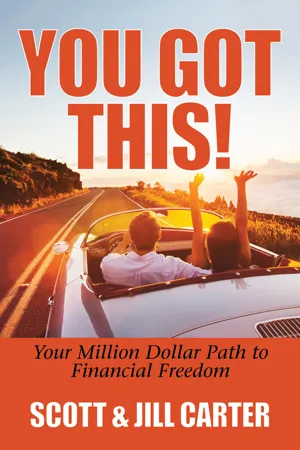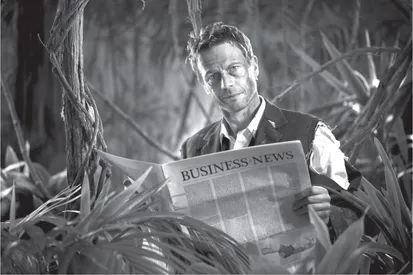![]()
CHAPTER 1
Why Now? Why Us?
Have you ever eaten frog legs? In the small Midwest towns where we grew up, frog legs were tasty summer fare. The night before a barbeque, a few brave souls would prowl through the local ponds to gig frogs for the grill. The frogs had several advantages in evading their hunters—it was dark, they were camouflaged, and they could jump. Nature was on their side. But technology was on ours! Armed with advanced weaponry of a three-pronged gig and a flashlight, the frogs were outmatched. When the light hit the frog’s eyes, it froze. The gig finished the job making for a successful BBQ the next day.
In October 2008, as the stock market plummeted 800 points in a day, investors froze. Like the frogs the moment before defeat, the Great Recession paralyzed us. In the twelve months that followed, the market lost 50% of its value, home values dropped, careers vaporized, companies disappeared and bankruptcies accelerated.
Looking back, it’s shocking that after the Recession, Americans did so little to protect and preserve wealth. We were completely unprepared. We naively assumed the crash was a temporary glitch and the markets would quickly recover. Still paralyzed by the Recession’s metaphorical gig, we refused to acknowledge our own precarious financial survival. One thing became very certain: financial security wasn’t a given anymore. If we wanted the retirement we dreamed of having, we would have to work smarter and harder to attain it.
Fortunately, it’s never too late to create and preserve wealth, no matter where life finds you. In order to do so, you’ve got to save more consistently in your early years, spend more wisely in your money accumulation years and invest more strategically in your wealth preservation years.
Americans are not Saving Enough Money
GoBankingRates.com published a 2017 survey revealing that Americans fail to save adequately. Out of 8,131 adults who were asked about saving money, 57% had less than $1,000 saved, and 39% had saved nothing. Moreover, an article published on MarketWatch.com titled, Half of American Families are Living Paycheck to Paycheck, quotes a recent survey finding that 49% of employees are “anxious or fearful about their current financial well-being.”
While lack of personal savings is a major concern, nearly half of those surveyed are anxious about their current financial well-being. More disconcerting still is the fact that those surveyed could not contemplate their future financial station because they existed paycheck to paycheck.
Many are Income Rich and Retirement Poor
We meet lots of people—many just like us—fully engaged in work and life who are comfortable living “income rich.”
However, this myopic focus may force us to eventually stare retirement in the face unprepared. It’s pretty simple: If you spend it now, you won’t have it later. Is this happening to you?
Are you income rich, yet retirement poor?
It’s never too late to stop this cycle, and this book is our contribution to your retirement. Use our experiences, both good and bad, to help you take the wheel and steer your retirement to the destination you desire.
Social Security will NOT be Enough
According to the Social Security Administration, in 2018 the average recipient receives $1,404 every month or $16,848 annually in retirement benefits. Sure, there’s an annual cost of living adjustment (COLA); however, estimates are that it will average only 2% per year over the next 20 years. If you were to retire today at age 65, chances are you’ll live at least another 20 years. Applying that adjustment, upon your 85th birthday party, you would be looking at a yearly income of about $25,000.
Of course, this dismal annual fixed income holds true only because we assume our country’s politicians will figure out how to continue adequately funding the Social Security trust funds in perpetuity. Even so, how far does $16,848 go today, and how far do you think $25,000 will go 20 years from now?
Our plan may not be your plan, but this information is a foundation for good decisions.
This is the first in a series of books focusing on planning and protecting your financial future. Details in the next few chapters will expand on dramatic changes in the financial world. Then we will move into a systematic planning process. We’ll give you some easy-to-follow steps for how you can prepare for retirement, no matter how young or old you are. In the last few chapters we’ll offer some practical tips on how to set the right course to financial freedom.
So, Why Us?
As a couple, we’re a textbook example of overconfidence in our investments and the economy. Before 2008, we each worked years in our respective careers building our wealth. We invested heavily in the stock market and in real estate.
As two business executives we lived very comfortably, with houses, stock plans and multiple sources of money that was much too easy to borrow. Of course, that’s just what we did.
Our confidence in the quality of our investments led us to be overleveraged in some cases. Our dollar-based assets included real estate with high loan-to-value ratios. We simply could do no wrong or see any downside to our investment strategies.
When the financial crisis hit, it was like watching a disaster movie—only it was real. We watched major companies collapse including American International Group (AIG), whose stock dropped 98%.
As for our real estate investments, we lost 50% in value almost across the board. Those banks and lenders who only months before were happy to loan us more for leverage were on a different track after the crisis. They demanded payback or paydown of balances to reduce the loan-to-value ratios into a more secure 75% to 80% range.
We resurfaced from this devastating financial disaster because we were in our 40s and earning good incomes. Many, especially older people with retirement accounts and lower incomes, were not so fortunate.
We vowed in the midst of that disaster to become smarter about investing. We committed to learning more about risk, volatility, diversification, balance, and strategic investing. As we educated ourselves and began the road to smarter financial planning, we realized that we didn’t want to see others fall into the same traps.
This book condenses our experiences and learning curve to help others avoid our mistakes and leverage our success after the crash.
The learning curve we offer applies to both individuals and couples. As a couple, we did find an element of yin-yang when making investment decisions, and sometimes our opposite views made us more advantageously deliberate. But each of us has differing risk tolerances and ideas. You’ll occasionally find our opposing viewpoints popping out now and then in these books. That’s reality for investing couples. We each have unique qualifications and experience to share, so allow us to introduce ourselves. Though distinct, our mutual goal is to help you improve on past results or start out right in building a secure financial future.
Why Scott?
When I first met Scott, his charisma and can-do attitude attracted me immediately. Little did I know that Scott (the company’s assistant to the CEO) would give me (a brand new corporate attorney) one of my first assignments. He was so charming that I wanted to see him squirm so I, of course, said no! Many months later when he asked me another question—the question—I said yes. It’s hard to turn down doing life with a highly motivated and exceptionally captivating young executive.
Sophocles said, “there is no success without hardship.” I attribute much of Scott’s success in life to his ability to overcome adversity and challenges. He was not born with a silver spoon in his mouth. Rather, he climbed over obstacles and always seemed to find a way to generate money to make ends meet.
Raised in a small town in rural Ohio, baling hay and playing baseball were required activities. Because Scott grew up in a low-income family, he quickly learned the importance of perseverance and tenacity in achieving dreams.
Scott has always used his entrepreneurial talents to survive and thrive. He’s done some tough selling jobs, from Fuller Brush products to World-War-II-era window replacements in Kentucky. He managed to thrive singing and playing the piano in restaurants even though he couldn’t read notes in the bass clef. And, there was a stint as a bookkeeper in a local business while he was playing professional baseball for the New York Yankees and trying to make it to the big-league “show.”
He launched his post-baseball career as an entry-level insurance underwriter, but quickly moved up in the company, learning to manage and direct operations, underwriting and marketing. His unquenchable entrepreneurial spirit drove him to become the chief operating officer of a financial services start-up, which then led to him running a direct-to-consumer business for another large publicly traded company.
At some point along his journey to realize a lifelong dream of owning a company, he asked me about investing in franchises. Knowing that Scott could build businesses into great companies, I was all ears! That is, until I learned that what he was considering a group of quick oil-change franchises. It was the only time I can remember saying no to his career opportunities.
He took my rejection in stride and moved on to becoming part-owner of several commodities investment companies, where he used his extensive experience to turn them into industry leaders. Now, he’s fulfilled his dream and owns his own investment company.
I love to watch Scott host a show or speak in front of large audiences. He’s dynamic on national news and financial media outlets, and he helps people better their lives through educational videos, live webinars and social media platforms. He’s really good in front of the camera. I’m good behind that camera. I suppose the combination makes us great partners.
I also love his heart for people. He’s a huge proponent of supporting our Veterans and helping young men and women launch their careers in ways that can make an immediate impact on the world. That’s why he has served on a variety of boards in the education, political and nonprofit sectors of our country. But most of all, I love how he loves our now-grown kids. While he was less of a helicopter parent than I (I’ve been accused of being a lawnmower parent), he would sacrifice everything for them.
Why Jill?
When I first met Jill, she was just starting out as a young corporate attorney. I was drawn to her intellect and drive. After she declined to accept a work assignment from me, I found my interest boosted even more! There’s nothing like a stretch goal to get the mind working overtime.
As I got to know her better, I learned right out of the gate that she was wicked smart, sassy, personable, independent and extremely motivated. Because office romances rarely work long-term, we both ended up moving to different companies. During the early years of our marriage, I watched her masterfully move from law to sales to public relations to eventually managing all corporate affairs. She loved the variety of duties of her executive-level responsibilities—no one day being the same.
Jill grew up much differently than I. She was born into a successful family that valued higher education. In fact, her dad was a university president. She never had to worry about money. She does have an entrepreneurial spirit at times but is happier taking existing organizations to the next level. More measured than I, she’s helped me avoid some financial potholes in my own businesses.
As I mentioned, I’ve watched Jill build high-impact organizations, including as a chief operating officer of an internet company. Then, recognizing that our church needed more operational and strategic expertise to take it to the next level, she moved into the nonprofit world as its executive director. Now she spends her time consulting corporations on strategic communications, public relations, issues management and integrated marketing.
Personally, I love to see her leading a project, managing a crisis or trying her best to win a bet with me on the golf course (which she claims she will do in the next ten years!). Because of her areas of expertise and legal background, she brings much to the corporate table. She’s my first draft pick no matter the team or the project.
If summarizing her success, Jill might say she “fakes it until she makes it.” In reality, she fakes nothing and manages everything. I’ve never met anyone more committed to faith and family as well as juggle a successful career. She adds much value wherever she puts her energy. It is mind-boggling how she has maneuvered and multi-tasked her ambitions throughout the years! But it’s probably why I still beat her on the golf course. (At least that’s my story and I’m sticking to it.)
![]()
CHAPTER 2
The Jungle
Have you ever found yourself in unfamiliar territory with no idea how to navigate your way out?
Our daughter loves escape rooms. If you haven’t experienced one, it’s a physical adventure game where you are locked in a room with several people. Using clues, strategy and logic, you solve a series of puzzles in order to e...


